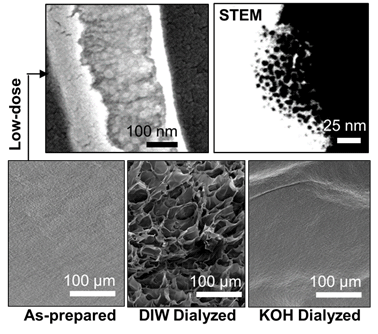Article contents
Direct visualization of nano and microscale polymer morphologies in as-prepared and dialyzed polyampholyte hydrogels by electron microscopy techniques
Published online by Cambridge University Press: 13 August 2018
Abstract

The structure of polymer networks in hydrogels determines the properties. In this study, we investigated the structure of a charge-balanced polyampholyte, poly(4-vinylbenzenesulfonate-co-[3-(methacryloylamino) propyl] trimethylammonium chloride). From as-prepared samples, nanoscale globules were visualized in polyampholyte hydrogels for the first time. The impact of dialyses processes on polymer structures were also studied. In deionized water, salt ions are leached out, thus polymer chains undergo zipping process to form cellular structure with micrometer-thick polymer walls that allow mechanical toughness to the hydrogel. Samples dialyzed in 6 M potassium hydroxide solution did not show such cellular structure, as in the case of as-prepared samples.
- Type
- Research Letters
- Information
- Copyright
- Copyright © Materials Research Society 2018
References
- 4
- Cited by


